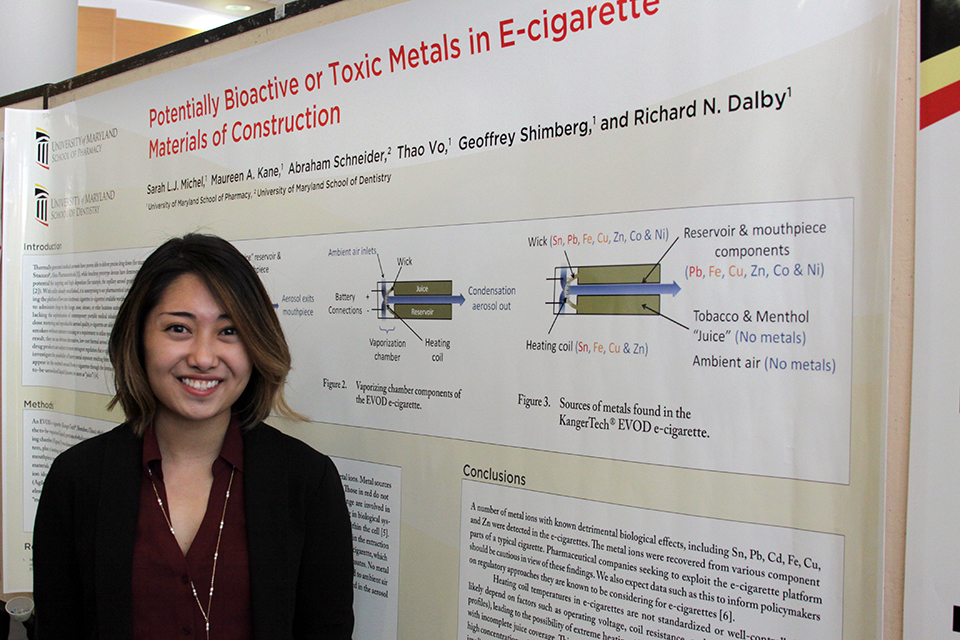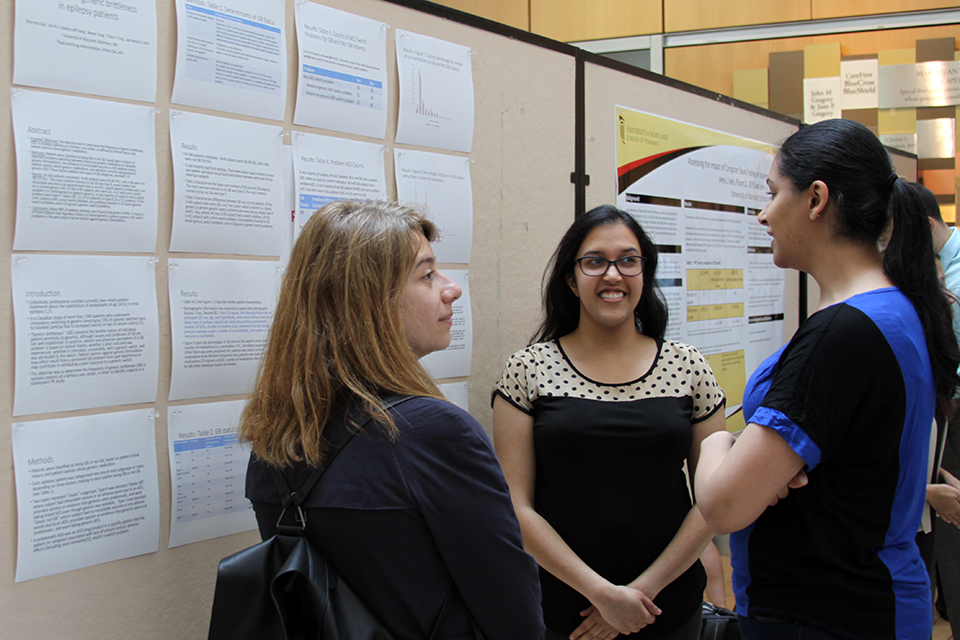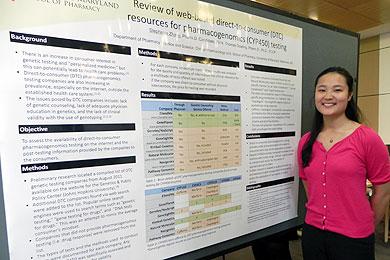Annual Event Spotlights SOP’s Up-and-Coming Researchers
Research Day offers an opportunity for students and trainees to showcase their current research and network with potential collaborators.

By Malissa Carroll
April 22, 2016
More than 70 student pharmacists, pharmacy residents, graduate students, and postdoctoral fellows participated in Research Day at the University of Maryland School of Pharmacy on April 13. Created to highlight the breadth and depth of research among the School’s students and trainees, this annual event offered an opportunity for participants to showcase their current work, as well as network with potential collaborators.
“In addition to giving our students, residents, and postdoctoral fellows a chance to share their latest work, Research Day provides those who participate with an opportunity to learn more about the research being conducted in other departments across the School,” says Peter Swaan, PhD, associate dean for research and graduate studies and professor in the Department of Pharmaceutical Sciences (PSC) at the School of Pharmacy. “It is our hope that this venue will stimulate new collaborations within the wide range of disciplines across the School.”
To kick off this year’s event, several students, residents, and postdoctoral fellows were selected by their departments or programs to deliver presentations highlighting their recent research. The first student to address the audience was Tomefa Asempa, a fourth-year student pharmacist who, under the mentorship of Julie Zito, BSPharm, PhD, professor in the Department of Pharmaceutical Health Services Research (PHSR) at the School, examined trends and patterns of psychiatric and non-psychiatric emergency department visits among Medicaid-insured youth.
“Visits to the emergency department – regardless of the reason for which they occur – are expensive, and indicate a disruption in care for individuals with chronic illnesses,” said Asempa, whose research uncovered a significant increase in psychiatric-related emergency department visits among Medicaid-insured youth from 2007 to 2012, particularly for those youth in foster care and youth living with disabilities. “Because we often do not think about mental illnesses as chronic conditions, there is not a lot of information available about why children, in particular, visit the emergency department for psychiatric-related symptoms. Fortunately, our research team had access to a wide range of administrative claims datasets that allowed us to begin to address this issue.”
Also delivering presentations during Research Day were Tabassum Majid, PhD, a postdoctoral fellow in PHSR, and Katharine Briggs, PhD, a postdoctoral fellow in PSC. Majid presented her research eliciting care management and treatment preferences from family caregivers of individuals with Alzheimer’s disease and related dementias, while Briggs spoke about her work to determine whether water proton nuclear magnetic resonance (NMR) could detect conformational transitions (changes in the shape of a macromolecule) in amphiphilic molecules (molecules with both polar and nonpolar regions).
Under the guidance of Susan dosReis, BSPharm, PhD, associate professor in PHSR, Majid took a patient-centered approach to her research, conducting interviews and organizing focus groups for nearly 30 caregivers of individuals with Alzheimer’s disease and related dementias to better understand how they prioritize the benefits and risks associated with available care options. “Caring for individuals with Alzheimer’s disease and other dementias presents a lot of unique challenges. There are only five medications approved by the Food and Drug Administration to treat these conditions on the market, and many patients opt not to take those medications because they do not see any real benefit. As a result, it is necessary for us as researchers to look beyond pharmacological interventions to better understand the other options that caregivers might be exploring for their loved ones,” she said.
Working in the laboratory of Yihua Bruce Yu, PhD, professor in PSC, Briggs conducted a series of experiments using an amphiphilic molecule known as FIT-27 to verify water NMR as a method of detection for conformational transitions, measuring the chemical shift changes, relaxation rates, and diffusion coefficients for both water and fluorine – another imaging agent – to determine if both detected the same molecular transitions in FIT-27. “Previous research in our laboratory has shown that water NMR can detect aggregates of drug products, so the results from these studies were very exciting to us. We now have data that shows promise for using water NMR to also detect conformational transitions, and are looking forward to continuing these studies to develop a novel way of measuring biologics and conducting quality control across the pharmaceutical industry,” she said.
A poster session held later during the event presented an opportunity for faculty, staff, and students to network and learn more the cutting-edge research being conducted by up-and-coming researchers across the School. One of the posters showcased research conducted by Joey Mattingly, PharmD, MBA, assistant professor in the Department of Pharmacy Practice and Science (PPS) at the School and a graduate student in the School’s PhD in PHSR program, where he is currently examining methods to measure the economic burdens of disease and the actions that decision makers can take to improve how health care dollars are spent.
“Research Day is a wonderful opportunity to highlight the tremendous work being done by the School’s students, residents, and postdoctoral fellows, with the most valuable part being the role that it plays in the development of these young researchers,” said Mattingly. “After my first year teaching at the School, I applied to the PhD in PHSR program. My work focuses on the field of pharmacoeconomics. Although I have presented several posters at national meetings as a pharmacy practitioner, having the opportunity to participate in Research Day was particularly special for me, as I not only served as a mentor to two pharmacy residents who had posters on display, but also had an opportunity to share my own work as a graduate student.”



